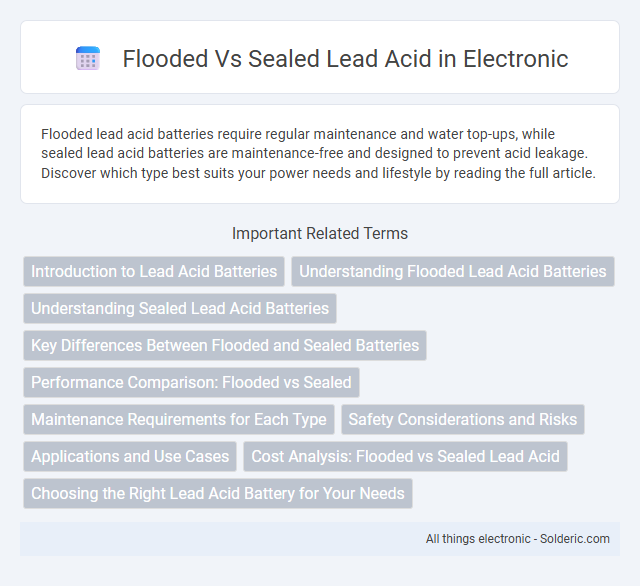Flooded lead acid batteries require regular maintenance and water top-ups, while sealed lead acid batteries are maintenance-free and designed to prevent acid leakage. Discover which type best suits your power needs and lifestyle by reading the full article.
Comparison Table
| Feature | Flooded Lead Acid | Sealed Lead Acid (SLA) |
|---|---|---|
| Design | Flooded electrolyte, vented | Absorbent glass mat or gel, sealed |
| Maintenance | Requires regular water topping and checks | Maintenance-free, no water addition |
| Safety | Risk of acid spills and gas emission | Low spill risk, minimal gas emission |
| Lifespan | 3-5 years with proper maintenance | 4-6 years, generally longer than flooded |
| Cost | Lower upfront cost | Higher initial cost |
| Performance | Better deep discharge capability | Better in sealed, vibration-prone environments |
| Applications | Automotive, stationary energy storage | UPS, mobility devices, emergency lighting |
Introduction to Lead Acid Batteries
Lead acid batteries include two primary types: flooded (wet cell) and sealed (maintenance-free) variants, each offering distinct advantages for energy storage. Flooded lead acid batteries contain a liquid electrolyte that requires regular maintenance and venting to prevent gas buildup, making them suitable for stationary applications like backup power systems. Sealed lead acid batteries, such as Absorbent Glass Mat (AGM) and Gel cells, feature immobilized electrolytes that minimize leakage and enable operation in diverse orientations, providing convenience and safety for automotive and portable devices.
Understanding Flooded Lead Acid Batteries
Flooded lead acid batteries contain liquid electrolyte that requires regular maintenance, including topping off with distilled water to prevent acid stratification and corrosion. They offer reliable performance, higher surge currents, and are typically more affordable compared to sealed lead acid (SLA) batteries. Flooded batteries are commonly used in applications such as automotive starting, renewable energy systems, and backup power due to their durability and cost-effectiveness.
Understanding Sealed Lead Acid Batteries
Sealed Lead Acid (SLA) batteries are maintenance-free, designed with a valve-regulated lead-acid (VRLA) system that prevents electrolyte leakage and allows gas recombination during charging, enhancing safety and usability. Unlike flooded lead acid batteries, SLA batteries are sealed and do not require water replenishment, making them ideal for applications requiring low maintenance and reliable performance in confined spaces. SLA batteries exhibit lower self-discharge rates, better resistance to vibration, and a more compact, spill-proof design, which benefits backup power systems, uninterruptible power supplies (UPS), and mobility equipment.
Key Differences Between Flooded and Sealed Batteries
Flooded lead acid batteries feature liquid electrolyte that requires regular maintenance, including topping off with distilled water, while sealed lead acid batteries are maintenance-free with a fixed electrolyte gel or absorbed glass mat. Flooded batteries generally offer higher tolerance to overcharging and better performance in deep cycling, making them suitable for heavy-duty applications, whereas sealed batteries provide enhanced safety, leak resistance, and flexibility in mounting positions. Understanding these key differences helps you select the right battery type for your specific energy storage or backup power needs.
Performance Comparison: Flooded vs Sealed
Flooded lead acid batteries offer robust performance with high discharge rates and easy maintenance, making them suitable for applications requiring frequent deep cycling. Sealed lead acid batteries, including AGM and gel types, provide enhanced safety with spill-proof design and lower self-discharge rates, ideal for environments with limited ventilation. Your choice depends on balancing maintenance considerations with performance needs, where flooded batteries excel in longevity and sealed batteries prioritize convenience and safety.
Maintenance Requirements for Each Type
Flooded lead acid batteries require regular maintenance including water level checks and electrolyte refilling to prevent damage and ensure optimal performance. Sealed lead acid batteries, also known as valve-regulated lead acid (VRLA), are maintenance-free since the electrolyte is immobilized, eliminating the need for water top-ups and reducing the risk of acid spills. Flooded batteries are ideal for applications where routine maintenance is feasible, while sealed batteries offer convenience and safety in environments where maintenance may be challenging.
Safety Considerations and Risks
Flooded lead acid batteries pose safety risks due to electrolyte spillage and hydrogen gas emissions, requiring proper ventilation and maintenance to prevent acid burns and explosions. Sealed lead acid batteries offer improved safety with minimal risk of acid leakage and lower gas release, making them suitable for enclosed or poorly ventilated environments. Both types require careful handling and adherence to manufacturer guidelines to ensure safe operation and longevity.
Applications and Use Cases
Flooded lead acid batteries are commonly used in automotive, marine, and backup power applications due to their high tolerance for overcharging and lower initial costs. Sealed lead acid batteries, also known as AGM or gel types, are preferred in environments requiring maintenance-free and spill-proof solutions, such as UPS systems, medical equipment, and portable electronics. Your choice between the two depends on factors like ventilation availability, maintenance capacity, and specific power needs.
Cost Analysis: Flooded vs Sealed Lead Acid
Flooded lead acid batteries typically cost less upfront compared to sealed lead acid (SLA) batteries, making them a budget-friendly choice for large-scale applications. However, flooded batteries require more maintenance and have shorter lifespans, which can increase long-term ownership costs. Sealed lead acid batteries, including AGM and gel types, offer higher initial costs but lower maintenance expenses and longer service life, often resulting in better cost efficiency over time.
Choosing the Right Lead Acid Battery for Your Needs
Flooded lead acid batteries offer lower upfront costs and easier maintenance, making them ideal for applications requiring frequent watering and ventilation, such as backup power systems. Sealed lead acid (SLA) batteries provide spill-proof, maintenance-free operation with better resistance to vibration, suited for portable devices and enclosed environments. Selecting the right lead acid battery depends on factors like budget, maintenance preferences, installation location, and performance requirements.
Flooded vs Sealed lead acid Infographic

 solderic.com
solderic.com